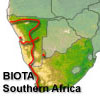 



Weather data
A large number of automatic weather stations has been implemented in the frame of the BIOTA AFRICA project by the Namibian National Botanical Research Institute (NBRI) and the Group "Biodiversity, Evolution and Ecology" (BEE) of the University of Hamburg. The website offers hourly updates of data and graphs of a large number of weather parameters.

|
 BIOTA Southern Africa - DS&T Project 3
BIOTA Southern Africa - DS&T Project 3
Main |
DS&T 03 |
Title |
Development of biodiversity rapid assessment methods in the Southern African biodiversity hotspots |
Project leader(s) |
Prof. Michael Samways
Department of Entomology and Centre for Agricultural Biodiversity, University of Stellenbosch, Private Bag X1, Matieland, 7602.
|
Project description |
There will be a major predator component (3 years/PhD or MSc if no suitable candidate) and a related flagship herbivore component (2 years/MSc). There will be paired sites (natural vs disturbed) at Elandsberg, Cape Point, Helderberg NR/Cordoba, Jonkershoek/Bottelary and Riverlands, where sampling is already taking place. Sampling will be with methods that are well-established. Univariate and multivariate statistics, including Canonical Correspondence Analysis and Discriminant Analysis will be used. Besides development of biodiversity profiles of the Cape Floristic Kingdom and of associated transformed lands, there will be a set of management recommendations to enable sustainability of the CFR biodiversity. |
SADC and International Links |
This project proposal is directly and strongly linked with ongoing BIOTA projects (Dr Connie Krug, Professor Melodie McGeoch, Mr Sven Vrdoljak, Ms Carmen Kassier), and future BIOTA projects. Even the same sites will be used. It is also aimed at complementing Dr Krug’s current proposal, in that hers is in the more arid and ours in the moister areas. It also builds on work we completed under the EU/FP5, and now largely published. The aim is for there to be a team of interactive students. Besides links with the faunal component of BIOTA, there will be links with botanical and abiotic components. There will also be strong links with our WWF project “Conservation of the endemic invertebrate fauna of the Cape Peninsula” and with our Working for Water project “Assessing the impacts of invading alien plant clearing on the recovery of biodiversity in freshwater systems using river health indicators”, and with our DST Centre of Excellence/Centre for Invasion Biology project “ Effect of invasive alien riparian trees on invertebrate biodiversity” and with our NRF project “Insect conservation biology”. This means that several groups of students will be working together. This project also links with the Inland Invertebrate Initiative (national) and the IUCN/ SSC Southern African Invertebrates Specialist Group of which I am Chair. We link internationally with the Expanding the Ark Coalition, Alliance for Zero Extinction and IUCN/SSC. Currently we are negotiating an EU proposal on ecosystem services and stability with University of Jena, Rothamstead Experimental Station and others. A student, Ms Sylke Nestmann, is already planned to be working with us. All these projects link and feed into each other through the species (fine filter) level (i.e. Red Listing) and the community (coarse filter) level (i.e. ecosystem services). This project, through the IUCN/SSC Southern African Invertebrate SG, is acting as ‘ombudsman’ for invertebrates in the processing of invertebrates in the Biodiversity Act, via DEAT (contact Dr Gert Willemse and Thea Carroll). |
|
|






 Go to the WeatherNet
Go to the WeatherNet BIOTA Southern Africa - DS&T Project 3
BIOTA Southern Africa - DS&T Project 3